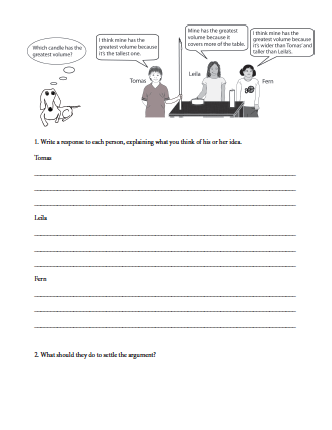Volume Concept Cartoon
This cartoon was developed to probe students’ understanding of volume as a 3-dimensional measure of the amount of space an object occupies. At issue is whether students differentiate volume from length (height) or area. Length is very salient to children, so they sometimes focus on that. In everyday language, children often use the same words “takes up space” to describe area (the piece of paper covers most of the space on my desk) and to describe volume (the basketball takes up more space than the golf ball). Unless these two meanings for the same word (space) have been explicitly addressed, students may continue to confuse area and volume.
A second issue is whether they can use their experience measuring the volumes of liquids and irregularly shaped solids (building replicas with centimeter cubes or displacement of water) to come up with a method for comparing the volumes of the three candles in this concept cartoon.
This cartoon is typically used after Investigation 4.3, What happens when we add earth materials to water?
Things to look for in student responses
1. How do students use the information in the drawings to think about comparing the volumes of the three candles?
Neither Tomas, Leila, or Fern is reasoning accurately about how to compare the three volumes.
- Some students may confuse volume with length or height and agree with Tomas.
- Others may confuse volume with area and agree with Leila.
- Still others may agree with Fern because she mentions area and height but fails to recognize that Fern would also need to know the areas and heights of all three candles to compare their volumes.
2. From the drawing alone, it is hard to tell which candle occupies the most space so students have to think of what they might do to settle the argument.
- Some students may reason that the candles are all made of the same material (wax) and if you could melt them down and pour the wax from each one into identical containers you could compare the amount of space each one occupies.
- Other students may suggest that they use centimeter cubes to build replicas of each candle, count the number of cubes, and compare them.
- Still others will suggest using a container of water that will accommodate any of the candles, marking the water level, and seeing which candle displaces the most water (makes the water level rise higher).
- Some students imagine each candle as a thin-walled container and imagine comparing the amount of water or number of objects such as centimeter cubes that could be held by each.




